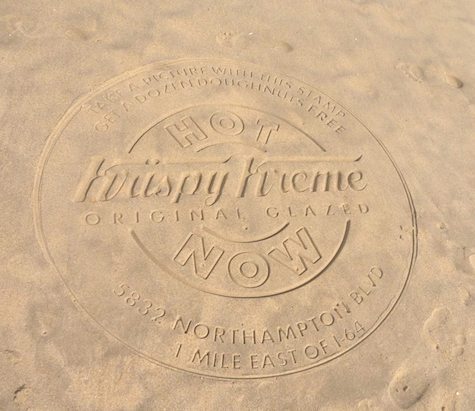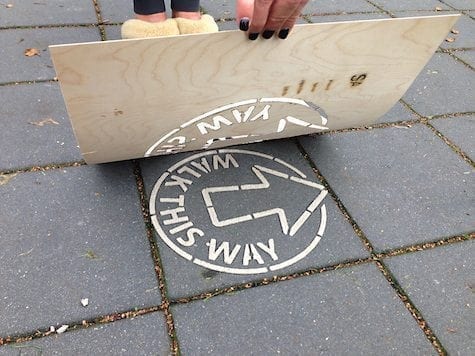Brand With Sand: How to Make [Almost] Zero-Waste Outdoor Ads
By Jim Bowes, Guest Blogger | November 4, 2015
In this blog post, I’ll look at three advertising techniques that use common sand. These do-it-yourself techniques are easy to execute, very affordable, minimally harmful and hugely impactful.
In my last post, I discussed how businesses can use natural media like sand to advertise outdoors without so much waste. Since outdoor ads are often short-lived and traditionally use large amounts of paper, vinyl and solvent-based inks, there’s a great deal of opportunity when it comes to imagining more sustainable alternatives.
Aside from the fact that wasteful advertising might conflict with your sustainable values, it’s also pretty costly, which puts it out of reach for most small and medium sized businesses. For these businesses, natural media techniques aren’t just the more eco-friendly option – they’re the only option.
Sand is plentiful, sand can be found almost everywhere and even if you decide to buy sand, sand is cheap. These perks aside, I think the best part about using sand in your advertising is that it doesn’t produce any waste — it simply returns to nature as sand.
There are three sand-based natural media techniques: sand stamping, sand printing and sand embossing. Sand stamping uses sand in its most basic form, while sand printing and sand embossing mix sand with other natural materials to bind the particles and adhere them to various surfaces.
Sign Up for Pegable Post to get ideas, advice and resources on activating your Purpose sent right to your inbox.
Sand Stamping

Rangoli is an Indian artform in which patterns are created on the floor using materials such as colored rice, dry flour, colored sand or flower petals.
Sand stamping is not new — it’s been used in hotel ashtrays to produce hotel logos for decades. Though few hotels have ashtrays anymore, the technique is still used on beaches, in golf courses’ sand traps and in other areas where sand is plentiful.
To produce a sand stamp all you need to do is push a sand mold (template or Earthstamp®) into the sand. When the sand mold is lifted, an impression is left behind that can have an impressive amount of detail. These impressions are temporary, and they will degrade when people walk on them or when waves wash them away. Without interference from pedestrians and waves, they can last for many hours.

Photo courtesy of Bob from EarthStamp. Doughnut craving courtesy of Krispy Kreme.
One of the advantages of sand stamping is that one person can create hundreds of impressions per day. Though this technique requires an investment in a sand mold, there are no additional costs for supplies and a good sand stamp will last you for years.
Because a single mold can be used so many times, sand stamping can generate a return on investment many times higher than forms of outreach that allow you only one chance to make an impression. To make the most of this medium, it’s smart to invest in a mold with a message that will remain relevant for years to come. It’s also worth noting that sand molds work in the snow!
Sand printing mixes sand with natural binding materials that form an adhesive bond when moistened with water. The technique is a cross between Rangoli, also known as Kolam or Muggu, a form of folk art from India; and silkscreen printing. Like Rangoli, the sand printing technique uses a dry powder and like silkscreen printing, the sand is distributed through a mesh screen to create the design. Here’s a quick video illustrating how the technique works:
Sand prints can last up to two weeks in the right conditions and can be removed simply by wetting the print with water and scrubbing it with a hard brush. It is a fair weather technique as it must be applied in dry conditions so the sand mixture can set. Color pigments can be added to the sand mix to add color. One person can produce 60 to 80 prints per day with nothing but a template, sand mix, a window wiper and a garden sprayer.
Sand Embossing

SandBossed messages like this one can last weeks!
Sand embossing or SandBossing is the newest technique of the three, and like sand printing, it uses common sand mixed with natural binding materials. The sand mixture is pushed into a template and the excess mixture is scraped away. When you remove the template you’re left with a raised letter or image that is sharp and attractive.
The sand mix used with SandBossing dries to create a very strong and durable bond that can be walked on and can last for weeks if placed away from foot traffic. Colors can be added to the mix, though I personally find the color of the natural sand to be part of the beauty of the media.
Perhaps the biggest benefit of SandBossing is how easy it is to remove. Pouring a bit of water over the print releases the bond quickly so it can be wiped or brushed away with very little effort. The sand mix does not leave a residue and once broken down to its natural state, the sand simply blows away in the wind.
Using sand to communicate your messages requires the right tools, special sand mixes and some knowledge, but the techniques here present an exciting opportunity for those looking to explore alternative forms of outdoor advertising with minimal waste.
The best practices that I identified in my post on reverse graffiti still apply here, so don’t forget the three cardinal rules of advertising with natural media:
Do something new and spectacular;
Collect images, stories and videos to repurpose on other channels; and
Use your sustainable values to appeal to customers.
For the sake of transparency and openness, I think it’s important to say that the sand printing and SandBossing techniques I talk about here are my own innovations. There are other natural media companies beginning to offer their own do-it-yourself kits for these techniques, and this thrills me to no end. In the near future, I expect [and hope!] to see more established companies offering these kits as well.
My goal is to reduce the environmental impact of advertising by helping businesses promote themselves with easy and affordable natural media techniques. If you’re interested in using any of these sand-printing techniques, please feel free to reach out with questions.
Excited by these fresh ideas? Keep your eyes open for my next post which explores how you can use snow and ice in your outdoor ads!



